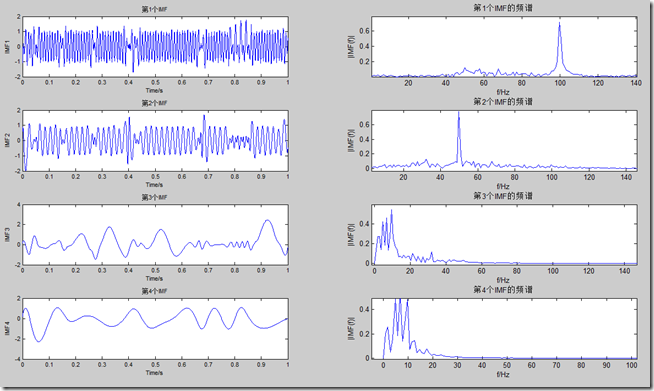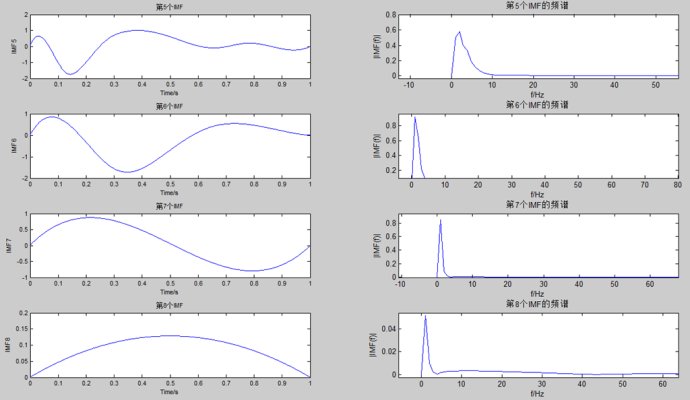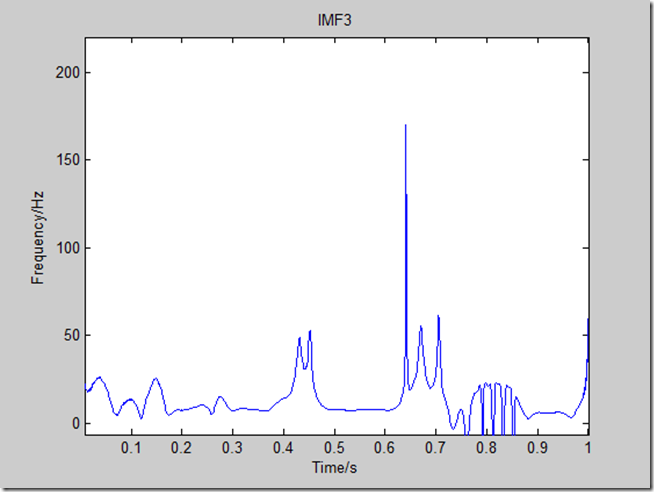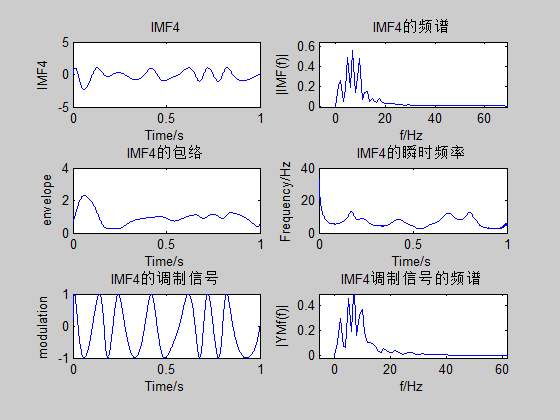经验模式分解基础理论
经验模式分解(Empirical mode decomposition ,EMD) is a nonlinear signal processing method developed by Huang et al. It can decompose a signal into a sum of functions, intrinsic mode functions (IMFs)。这些 IMFs必须满足两个条件: (1) the number of extrema and the number of zero-crossings either are equal or differ at the most by one; (2) the mean value of the envelope defined by the local maxima and the local minima is zero at all points.
时间序列 x(t)的详细分解过程可概括为如下:
(1) Identify all the local maxima and local minima of x(t), obtain the lower envelope
xl(t)
and the upper envelope
xu(t)
by interpolate the local minima and the local maxima, calculate the mean
m1=(xl(t)+xu(t))/2
.
(2) Extract the details,
h1=x(t)−m1
, check the properties of
h1
, if
h1
satisfies conditions
r
and
时间序列好的数据
x(t)
可以表示为 IMFs 与余差之和:
其中, n 是IMFs的个数;
使用MATLAB进行EMD分解
原始信号由3个正弦信号加噪声组成,如下

下面为做EMD分解的结果


第三次分解信号的瞬时频率如下

第四次分解信号的Hilbert分析

具体代码如下
test.m文件
clc
clear all
close all
% [x, Fs] = wavread('Hum.wav');
% Ts = 1/Fs;
% x = x(1:6000);
Ts = 0.001;
Fs = 1/Ts;
t=0:Ts:1;
x = sin(2*pi*10*t) + sin(2*pi*50*t) + sin(2*pi*100*t) + 0.1*randn(1, length(t));
imf = emd(x);
plot_hht(x,imf,1/Fs);
k = 4;
y = imf{k};
N = length(y);
t = 0:Ts:Ts*(N-1);
[yenvelope, yfreq, yh, yangle] = HilbertAnalysis(y, 1/Fs);
yModulate = y./yenvelope;
[YMf, f] = FFTAnalysis(yModulate, Ts);
Yf = FFTAnalysis(y, Ts);
figure
subplot(321)
plot(t, y)
title(sprintf('IMF%d', k))
xlabel('Time/s')
ylabel(sprintf('IMF%d', k));
subplot(322)
plot(f, Yf)
title(sprintf('IMF%d的频谱', k))
xlabel('f/Hz')
ylabel('|IMF(f)|');
subplot(323)
plot(t, yenvelope)
title(sprintf('IMF%d的包络', k))
xlabel('Time/s')
ylabel('envelope');
subplot(324)
plot(t(1:end-1), yfreq)
title(sprintf('IMF%d的瞬时频率', k))
xlabel('Time/s')
ylabel('Frequency/Hz');
subplot(325)
plot(t, yModulate)
title(sprintf('IMF%d的调制信号', k))
xlabel('Time/s')
ylabel('modulation');
subplot(326)
plot(f, YMf)
title(sprintf('IMF%d调制信号的频谱', k))
xlabel('f/Hz')
ylabel('|YMf(f)|');
findpeaks.m文件
function n = findpeaks(x)
% Find peaks. 找极大值点,返回对应极大值点的坐标
n = find(diff(diff(x) > 0) < 0); % 相当于找二阶导小于0的点
u = find(x(n+1) > x(n));
n(u) = n(u)+1; % 加1才真正对应极大值点
% 图形解释上述过程
% figure
% subplot(611)
% x = x(1:100);
% plot(x, '-o')
% grid on
%
% subplot(612)
% plot(1.5:length(x), diff(x) > 0, '-o')
% grid on
% axis([1,length(x),-0.5,1.5])
%
% subplot(613)
% plot(2:length(x)-1, diff(diff(x) > 0), '-o')
% grid on
% axis([1,length(x),-1.5,1.5])
%
% subplot(614)
% plot(2:length(x)-1, diff(diff(x) > 0)<0, '-o')
% grid on
% axis([1,length(x),-1.5,1.5])
%
% n = find(diff(diff(x) > 0) < 0);
% subplot(615)
% plot(n, ones(size(n)), 'o')
% grid on
% axis([1,length(x),0,2])
%
% u = find(x(n+1) > x(n));
% n(u) = n(u)+1;
% subplot(616)
% plot(n, ones(size(n)), 'o')
% grid on
% axis([1,length(x),0,2])plot_hht.m文件
function plot_hht(x,imf,Ts)
% Plot the HHT.
% :: Syntax`这里写代码片`
% The array x is the input signal and Ts is the sampling period.
% Example on use: [x,Fs] = wavread('Hum.wav');
% plot_hht(x(1:6000),1/Fs);
% Func : emd
% imf = emd(x);
for k = 1:length(imf)
b(k) = sum(imf{k}.*imf{k});
th = unwrap(angle(hilbert(imf{k}))); % 相位
d{k} = diff(th)/Ts/(2*pi); % 瞬时频率
end
[u,v] = sort(-b);
b = 1-b/max(b); % 后面绘图的亮度控制
% Hilbert瞬时频率图
N = length(x);
c = linspace(0,(N-2)*Ts,N-1); % 0:Ts:Ts*(N-2)
for k = v(1:2) % 显示能量最大的两个IMF的瞬时频率
figure
plot(c,d{k});
xlim([0 c(end)]);
ylim([0 1/2/Ts]);
xlabel('Time/s')
ylabel('Frequency/Hz');
title(sprintf('IMF%d', k))
end
% 显示各IMF
M = length(imf);
N = length(x);
c = linspace(0,(N-1)*Ts,N); % 0:Ts:Ts*(N-1)
for k1 = 0:4:M-1
figure
for k2 = 1:min(4,M-k1)
subplot(4,2,2*k2-1)
plot(c,imf{k1+k2})
set(gca,'FontSize',8,'XLim',[0 c(end)]);
title(sprintf('第%d个IMF', k1+k2))
xlabel('Time/s')
ylabel(sprintf('IMF%d', k1+k2));
subplot(4,2,2*k2)
[yf, f] = FFTAnalysis(imf{k1+k2}, Ts);
plot(f, yf)
title(sprintf('第%d个IMF的频谱', k1+k2))
xlabel('f/Hz')
ylabel('|IMF(f)|');
end
end
figure
subplot(211)
plot(c,x)
set(gca,'FontSize',8,'XLim',[0 c(end)]);
title('原始信号')
xlabel('Time/s')
ylabel('Origin');
subplot(212)
[Yf, f] = FFTAnalysis(x, Ts);
plot(f, Yf)
title('原始信号的频谱')
xlabel('f/Hz')
ylabel('|Y(f)|');
emd.m文件
function imf = emd(x)
% Empiricial Mode Decomposition (Hilbert-Huang Transform)
% EMD分解或HHT变换
% 返回值为cell类型,依次为一次IMF、二次IMF、...、最后残差
x = transpose(x(:));
imf = [];
while ~ismonotonic(x)
x1 = x;
sd = Inf;
while (sd > 0.1) || ~isimf(x1)
s1 = getspline(x1); % 极大值点样条曲线
s2 = -getspline(-x1); % 极小值点样条曲线
x2 = x1-(s1+s2)/2;
sd = sum((x1-x2).^2)/sum(x1.^2);
x1 = x2;
end
imf{end+1} = x1;
x = x-x1;
end
imf{end+1} = x;
% 是否单调
function u = ismonotonic(x)
u1 = length(findpeaks(x))*length(findpeaks(-x));
if u1 > 0
u = 0;
else
u = 1;
end
% 是否IMF分量
function u = isimf(x)
N = length(x);
u1 = sum(x(1:N-1).*x(2:N) < 0); % 过零点的个数
u2 = length(findpeaks(x))+length(findpeaks(-x)); % 极值点的个数
if abs(u1-u2) > 1
u = 0;
else
u = 1;
end
% 据极大值点构造样条曲线
function s = getspline(x)
N = length(x);
p = findpeaks(x);
s = spline([0 p N+1],[0 x(p) 0],1:N);
FFTAnalysis.m文件
% 频谱分析
function [Y, f] = FFTAnalysis(y, Ts)
Fs = 1/Ts;
L = length(y);
NFFT = 2^nextpow2(L);
y = y - mean(y);
Y = fft(y, NFFT)/L;
Y = 2*abs(Y(1:NFFT/2+1));
f = Fs/2*linspace(0, 1, NFFT/2+1);
end
HilbertAnalysis.m文件
% Hilbert分析
function [yenvelope, yf, yh, yangle] = HilbertAnalysis(y, Ts)
yh = hilbert(y);
yenvelope = abs(yh); % 包络
yangle = unwrap(angle(yh)); % 相位
yf = diff(yangle)/2/pi/Ts; % 瞬时频率
end





















 3861
3861

 被折叠的 条评论
为什么被折叠?
被折叠的 条评论
为什么被折叠?








